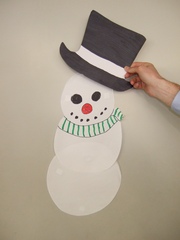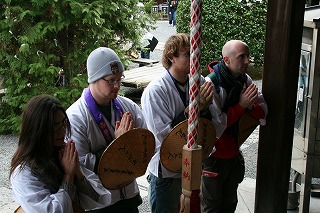On December 13, 2008, I did a global seminar at the Busshōzan International Exchange Center called "Making Sandwiches!" Using sandwich bread, roast pork, sliced cheese, lettuce, tomatoes, ketchup, and mustard, we made good old American style sandwiches. To go with that, we also made peanut butter and celery stick snacks. Rather than the sandwiches it was the celery sticks, which the students had never had until then, that ended up being the big hit of the day!
2008 Archive
 The last "Kodomo Club" event of 2008 was held on December 6th. Using PowerPoint, I gave a talk to the children about the origins of Christmas and the ways in which Americans spend the holiday. After that, we all played a game called "Frosty's Hat." In this game, the children put on blindfolds, spun around several times, and tried to put a hat fitted with magnets onto the head of a snowman that was posted on the blackboard. The kids gave it their dizzy best!
The last "Kodomo Club" event of 2008 was held on December 6th. Using PowerPoint, I gave a talk to the children about the origins of Christmas and the ways in which Americans spend the holiday. After that, we all played a game called "Frosty's Hat." In this game, the children put on blindfolds, spun around several times, and tried to put a hat fitted with magnets onto the head of a snowman that was posted on the blackboard. The kids gave it their dizzy best!I walked a small section of the Shikoku 88 Temple Circuit a few weeks ago as part of a project headed by Kagawa prefecture. We were fortunate to have nice weather and a fun group. Despite wearing down a bit near the end, I found the 18 Km walk to be very enjoyable. I have lived in Kagawa for over a year now, and visited several of the local temples on my own, but it was great to have a guide this time to explain about the pilgrimage in greater detail.
Better late than never. It's an old adage that I embrace and spurn with equal fervor. It's useful, yet almost too cliché to truly embrace. It was a convenient phrase when I was only just learning to snowboard a few winters ago, but now I find myself eagerly making use of it out to cover my embarrassment for not taking advantage of something that's almost literally been sitting right in front of me for four and a half years. It's not that I've completely ignored the 88 Temple Pilgrimage or Kukai himself. I've been to nearly a dozen temples connected to him, to Koyasan, to Toji. I even own a translated copy of "Kukai: The Universal", which I read months ago. And yet I've never really taken advantage of the fact that we have the most famous pilgrimage in the country right here on our island, with some of the temples practically a stone's throw away from where I live. Considering that I love going to temples and shrines, it's a bit surprising to think how rather nonchalant I've been. I guess I've often thought "I can always go some other time." or "Well, there's always later." for the whole time I've lived here. Much as I like to tell people back home about the pilgrimage, or how Kukai himself was born in this very prefecture, I've never really had much to do with the pilgrimage itself. I wanted to be a part of it, but I was hesitant, not wanting to seen as an imposter. But when we went our mini-henro experience and I saw other ALTs clutching their noukyouchou for the temples to sign and joined them in slipping on the white jacket, perching the conical hat on my head, and gripping the staff handed out by the organizers, I finally understood that it was perfectly acceptable to join in the tradition. I'd never realized that even among Japanese people there are myriad reasons people do the pilgrimage; for religious reasons, for health reasons, for the challenge of it, etc. I was pleasantly surprised to learn that as reasons go, it was ok to simply be someone who wanted to be closer to the culture around them, to experience something that had been going on for centuries first hand. That was what the outing at the end of November helped teach me, and it wasn't just from seeing my fellow ALTs join in, but from being included in the photographs of other henro and from being greeted with enthusiasm along the way, in warm, welcoming tones. I eagerly look forward to participating again, be it through something like this or on my own. Now that I have my trusty noukyouchou at my side, only 82 more temples to go!

We met at eight thirty on a late November Sunday, the air brisk and typical for a late autumn morning in Kagawa-ken. Over winter coats and woolen hats we layered crisp white byakue (pilgrim jackets) and straw conical hats, grumbling lightheartedly about our resemblance to a pack of walking marshmallows. Lastly, we added the most markedly "pilgrim" elements to our ensemble: purple sashes and wooden tsue (walking staffs) adorned by nearly all those who embark on the pilgrimage. The staffs were hand painted in Japanese calligraphy with "we two walk together," a proxy for the first pilgrim, the great Kukai (known posthumously as Kobo-Daishi) who is said to walk alongside each traveler.
I found out about the henro from my teacher at ipal, where I take japanese classes.
I expected a few foreigners from different countries and maybe some locals too.
Little did I know... I got off the train to discover all my JET friends there,(although I am not a JET)
Yes, it was ウジヤ ウジヤ with English speakers, so I didn't get to practice my Japanese that day. But I got the great opportunity to discover some of the shikoku pilgrim trail.
Mr McCabe did a wonderful job translating and was an inspiration to knuckle down and study Japanese. I felt a bit "gimmiky" at first in the henro outfit, but it's nice to all do something in unison, which is partly what the day was about. A great introduction to the 88 temples of Shikoku.

The Hachi-ju Hakkasho in One Day
I was blind and deaf. I couldn't see anything. Only darkness. The only guide was my hand which cautiously moved along the wall, inspecting every bump and groove in a desperate attempt to find my bearings. The silence seemed to echo throughout the tunnel, so much so that I felt I should interrupt it. But I couldn't. I wasn't allowed. I was told to keep my mouth shut (which is sometimes quite a challenge for me). At first the feeling was unnatural and so I made my way clumsily onward. The only consolation was knowing there was a person in front of me experiencing the same discomfort. Was I going mad?
If on a Late Autumn Day a Pilgrim
(With Apologies to Italo Calvino)
If on a Late Autumn Day a Pilgrim
Our entrance into the sanctuary of Doryuji was a quiet one, as we circled around the main hall from the rear instead of through the main gate. As we congregated in the space between the main hall and the hall dedicated to Kukai, we reflected on the nature of our coming path and of the six temples that were to be our day's destinations. As a mere 17 people among the 150,000 who would walk this path during this year alone, we could better appreciate our own significance in the cosmos.
After donning our straw hats, collecting our walking staffs, and receiving our stamps, our time at the 77th of Shikoku's 88 sacred temples was complete and it was time to go to the 76th Temple, Konzoji. As we backed out the front entrance with a last bow, it felt as if we were characters in a film running in reverse.
Thinking About The
About 1200 years ago when the monk Kukai returned to Japan after spending many years in China, he found his home country in disarray. Great political tensions filled the land, and with it favor over certain religions changed as swiftly as did the Emperors. Three different men took on the title of Emperor in the three years after Kukai's arrival. Taking an official court position in 809AD, Kukai spent the rest of his life writing enormously influential works on Shingon Buddhism and leading the establishment of a monastery community on
My Henro Reflection
The first time I ever visited Takamatsu station, I was surprised. I was just taking in the scenery, but I must have looked lost, because 5 people (both Japanese and foreign) stopped to offer me help within the first 10 minutes I was there. At first I was surprised. I had lived in Hiroshima City for a year before coming to Kagawa Prefecture. Despite it being an international city, the people there tended to avoid foreigners like me, even if we clearly were lost and needed help, because they were afraid they would have to use English. I later learned that because of countless pilgrims traveling the 88 Temple Circuit, the people of Shikoku are extremely hospitable, and will do their best to help visitors despite language and cultural barriers. I believe this is a big part of why I have come to love living in Kagawa so much.
My Henro Experience
Ready the Pilgrimage!
He woke up late in a place he knew he wasn't supposed to be. This wasn't his house in Tadotsu... "Where am I?" he thought. Quickly he rushed into the next room to awaken his friend and inform him of their soon to be tardiness. Quickly they threw things together in a hustle and bustle to get out the door as quickly as possible. Time was of the essence as soon the both of them would embark upon a journey spanning several different temples. Amazing journeys couldn't be started on an empty stomach; however, and they decided that eating about eight oranges a piece wasn't a bad idea.
The 1st one took place at Goshikidai. This time, the foreigners living in Kagawa walked along the pilgrimage road around Zentsuji Temple.
Transcending the Self for the Sum
For over a month, a haphazardly scribbled "88 Temples" occupied the Sunday November 30th space in my planner. Although I was excited to partake in the venture, I discovered very quickly that the experience I had imagined was only a minute aspect of ohenrosan. Without a doubt, being outdoors, being in great company, and sneaking in some cardio are important parts of the pilgrimage; but, as we walked the 12 kilometers from Tadotsu to Zentsuji I realized ohenrosan was much more than that. However, it wasn't until we listened to the priest's lecture at Zentsuji temple that I could put into words what that "more" exactly was. While explaining the significance of the temple and Buddhist teachings, the priest compared humanity to that of a beaded tapestry and human life to that of the beads. "If one bead is damaged," he stated, "it not only affects that one particular bead, but the entire tapestry, as well." These words enabled me to tie up the loose ends of my thoughts and see that when partaking in ohenrosan it doesn't matter if a person is Buddhist, Jewish, Hindu, Christian, Muslim, atheist or what have you, traveling Shikoku's 88 temples is about engaging in something larger than oneself.